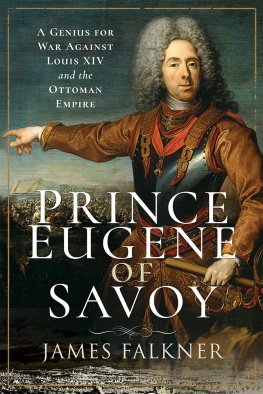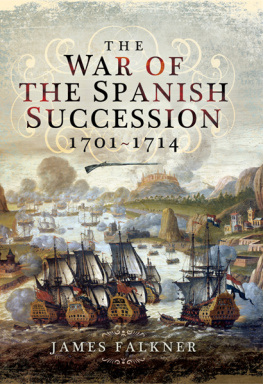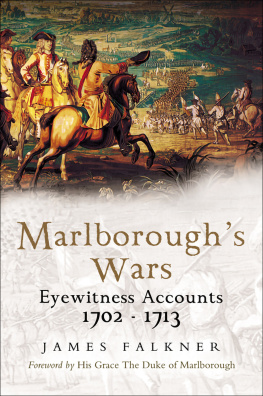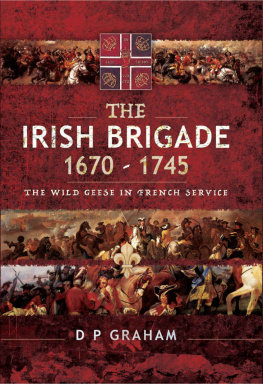The Battle of Fontenoy 1745
We have had a most bloody battle with the French; yesterday we began at five in the morning and left off at two in the afternoon, all which time the French kept cannonading us; I was forced to be very civil and make a great many bows to the balls for they were very near me. The foot were very sadly cut to pieces, for the French put grapeshot into their cannon and cut them down just as if they were shearing corn.
Wilson, A., The Story of the Guns , 1944, p. 29.
First published in Great Britain in 2019 by
PEN & SWORD MILITARY
An imprint of Pen & Sword Books Ltd
Yorkshire Philadelphia
Copyright James Falkner, 2019
ISBN 978-1-52671-843-3
eISBN 978-1-52671-841-9
Mobi ISBN 978-1-52671-842-6
The right of James Falkner to be identified as the author of this work has been asserted by him in accordance with the Copyright, Designs and Patents Act 1988.
A CIP catalogue record for this book is available from the British Library.
All rights reserved. No part of this book may be reproduced or transmitted in any form or by any means, electronic or mechanical including photocopying, recording or by any information storage and retrieval system, without permission from the Publisher in writing.
Pen & Sword Books Ltd incorporates the Imprints of Aviation, Atlas, Family History, Fiction, Maritime, Military, Discovery, Politics, History, Archaeology, Select, Wharncliffe Local History, Wharncliffe True Crime, Military Classics, Wharncliffe Transport, Leo Cooper, The Praetorian Press, Remember When, White Owl, Seaforth Publishing and Frontline Publishing.
For a complete list of Pen & Sword titles please contact
PEN & SWORD BOOKS LTD
47 Church Street, Barnsley, South Yorkshire, S70 2AS, England
E-mail:
Website: www.pen-and-sword.co.uk
or
PEN & SWORD BOOKS
1950 Lawrence Rd, Havertown, PA 19083, USA
E-mail:
Website: www.penandswordbooks.com
List of Maps and Plates
Maps
The fortresses of northern France and the southern Netherlands, 1745
The battle of Fontenoy, 11 May 1745
Plates
Maria-Theresa, Empress of Austria, Queen of Hungary and Bohemia.
Maurice de Saxe, Marshal of France.
William Augustus, Duke of Cumberland.
King Louis XV of France.
Lieutenant General Sir John Ligonier.
British infantry advancing, c .1745. A still from the excellent Stanley Kubrick film Barry Lyndon (1975).
French artillery in action, c .1745.
A French contemporary map of the battle of Fontenoy. Although some details are indistinct, the three-sided column of Cumberlands infantry can be seen breaking into the French position.
The siege of Tournai, 1745 (previously thought to represent the 1709 siege by Marlborough).
Tournai, rebuilt by Vauban, besieged by Saxe, 1745.
Introduction
In the grounds of the Hofburg Palace in Vienna, close to where the old, now long vanished, defensive walls once held back the army of the Ottoman Turks, stands a remarkably fine statue of Maria-Theresa, Empress of Austria and Queen of Hungary and Bohemia. She is suitably depicted as a grand and matronly figure, clad in her robes of state, her right hand stretched out as if dispensing justice, bounty and order, while in her left hand is the imperial sceptre, symbol of her power, and looking not unlike a field marshals baton. The apparent analogy is apt, as she was to prove herself a good war leader. Her left arm rests on a rolled parchment, and that innocent-looking paper is the Pragmatic Sanction, a document of complex technical legality, enacted in 1713 long before her birth, at the instigation of her father Emperor Charles VI. It was the symbol of the legitimacy of her power, although this was only in fact brought about by the eventual election of her husband as the emperor, so that Maria-Theresa, after much aggravation, conflict and delay, could style herself as empress. Even that event had to await the demise of the Wittelsbach claimant, the Elector of Bavaria, who had with French support assumed the disputed title, on grounds that were not without merit. The tale of the struggle to achieve this goal, to secure the imperial throne and make it good, runs like a tangled thread through this book, centred as it is on one of the most significant days, 11 May 1745, of what had become a Europe-wide conflict.
A teeming day of battle, Fontenoy was brutal and bloody, fought in a long-ago war in pursuit of an arcane dispute that had set great nations at each others throats. Long remembered, but much misunderstood and often mis-represented, the hard-fought battle at Fontenoy sprawled across the fields and copses around that small village beside the river Scheldt, just a few miles from the great Vauban-designed fortress of Tournai (Doornick) in present-day Belgium. The contest was notable for the ferocity of the fighting, and the remarkable selfless gallantry of the soldiers in both the contending armies. The renowned Germanborn veteran Marshal of France, Maurice Saxe, pitched his French army against the British, Dutch, Hanoverian and Austrian coalition forces which comprised the allied army, led by William Augustus, Duke of Cumberland, young second son of King George II of Great Britain and Elector of Hanover. By curious coincidence there would be three sons of kings active on the field that day: Saxe (although illegitimate), Cumberland of course, and the French Dauphin (King Louis XV, although present at the battle, cannot be counted as such, as his own father, the Duke of Burgundy, died of measles before coming to the throne of France).
Saxe needed to deal Cumberland and his Austrian and Dutch colleagues a telling blow and throw his army back, if his newly begun siege of Tournai, with its Dutch and Swiss recruited garrison, were to proceed. Under the watchful eyes of the king and his son, in this challenging endeavour the marshal was entirely successful, despite being in such a poor state of health as would have flattened a lesser man. Both armies lost heavily, and the casualties suffered were almost eerily distributed evenly between the two each army ended the day intact though battered and all but exhausted. That being so, as there was clearly a crude arithmetical parity about the whole bloody occasion who then had won? Well, at the close of the action Cumberland had no choice but to withdraw from the field and regroup, and in so doing leave the governor of the garrison in Tournai to make what defence he could against daunting odds. As a result, the duke would prove unable that summer to maintain the concentration of his army in the field, to infuse any fresh purpose into what became a languishing campaign, or to counter a vigorous and very well conducted French offensive over much of the southern (Austrian) Netherlands. This inability to deal with the dismally unravelling allied campaign was made worse as his attention, and that of many of his British troops, would be diverted elsewhere by demands from London for their recall. Above all else, of course, it was clear that Marshal Saxe achieved his aim at Fontenoy and so had won the day with that as a springboard for fresh action, he went on to further notable successes while Cumberland did not, at least in the Low Countries.













